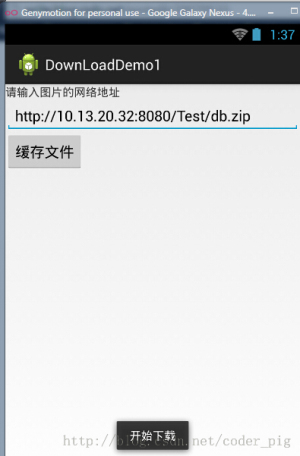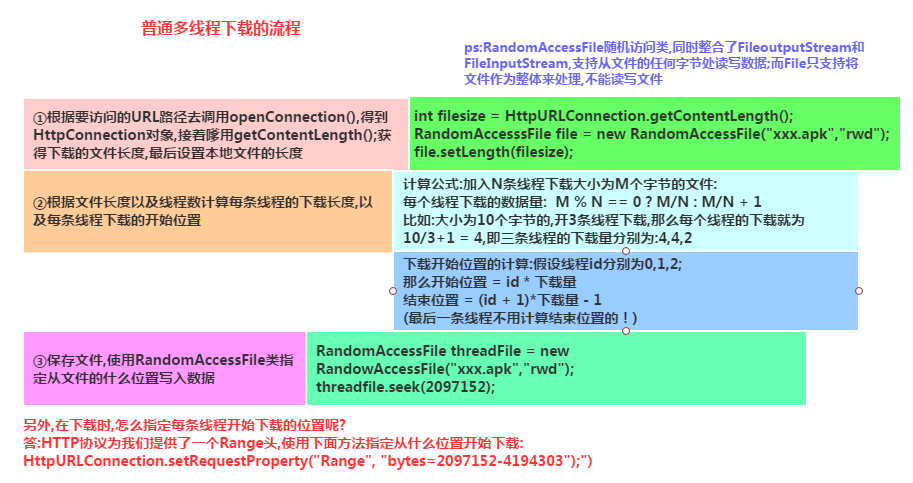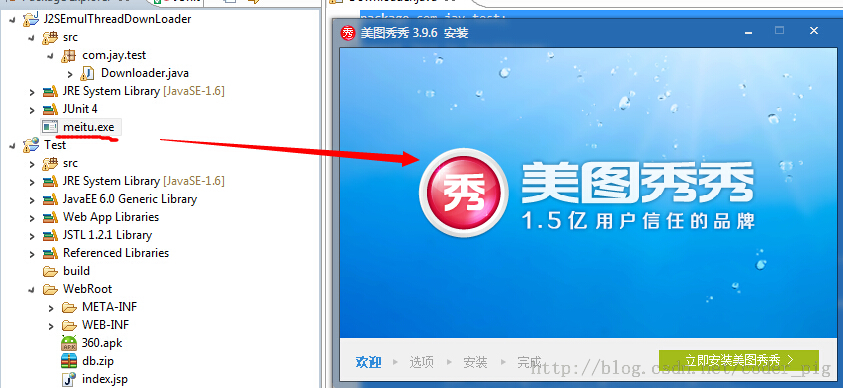# 7.3.2 Android 文件下载(1)
## 本节引言:
> 又是一个深坑,初学者慎入...本节将从普通的单线程下载 -> 普通多线程下载 -> -> 以及一个很实用的例子:利用Android那只DownloadManager更新apk 并覆盖安装的实现代码!好的,这样看上去,本节还是蛮有趣的,开始本节内容! PS:我们把整个完整的多线程断点续传放到下一节中!
## 1.普通单线程下载文件:
> 直接使用URLConnection.openStream()打开网络输入流,然后将流写入到文件中!
**核心方法**:
```
public static void downLoad(String path,Context context)throws Exception
{
URL url = new URL(path);
InputStream is = url.openStream();
//截取最后的文件名
String end = path.substring(path.lastIndexOf("."));
//打开手机对应的输出流,输出到文件中
OutputStream os = context.openFileOutput("Cache_"+System.currentTimeMillis()+end, Context.MODE_PRIVATE);
byte[] buffer = new byte[1024];
int len = 0;
//从输入六中读取数据,读到缓冲区中
while((len = is.read(buffer)) > 0)
{
os.write(buffer,0,len);
}
//关闭输入输出流
is.close();
os.close();
}
```
**运行结果**:
 
## 2.普通多线程下载:
我们都知道使用多线程下载文件可以更快地完成文件的下载,但是为什么呢?
> 答:因为抢占的服务器资源多,假设服务器最多服务100个用户,服务器中的一个线程 对应一个用户100条线程在计算机中并发执行,由CPU划分时间片轮流执行,加入a有99条线程 下载文件,那么相当于占用了99个用户资源,自然就有用较快的下载速度
**PS**:当然不是线程越多就越好,开启过多线程的话,app需要维护和同步每条线程的开销, 这些开销反而会导致下载速度的降低,另外还和你的网速有关!
**多线程下载的流程**:
> * 获取网络连接
> * 本地磁盘创建相同大小的空文件
> * 计算每条线程需从文件哪个部分开始下载,结束
> * 依次创建,启动多条线程来下载网络资源的指定部分

PS:这里直接创建一个Java项目,然后在JUnit里运行指定方法即可,
**核心代码如下**:
```
public class Downloader {
//添加@Test标记是表示该方法是Junit测试的方法,就可以直接运行该方法了
@Test
public void download() throws Exception
{
//设置URL的地址和下载后的文件名
String filename = "meitu.exe";
String path = "http://10.13.20.32:8080/Test/XiuXiu_Green.exe";
URL url = new URL(path);
HttpURLConnection conn = (HttpURLConnection) url.openConnection();
conn.setConnectTimeout(5000);
conn.setRequestMethod("GET");
//获得需要下载的文件的长度(大小)
int filelength = conn.getContentLength();
System.out.println("要下载的文件长度"+filelength);
//生成一个大小相同的本地文件
RandomAccessFile file = new RandomAccessFile(filename, "rwd");
file.setLength(filelength);
file.close();
conn.disconnect();
//设置有多少条线程下载
int threadsize = 3;
//计算每个线程下载的量
int threadlength = filelength % 3 == 0 ? filelength/3:filelength+1;
for(int i = 0;i < threadsize;i++)
{
//设置每条线程从哪个位置开始下载
int startposition = i * threadlength;
//从文件的什么位置开始写入数据
RandomAccessFile threadfile = new RandomAccessFile(filename, "rwd");
threadfile.seek(startposition);
//启动三条线程分别从startposition位置开始下载文件
new DownLoadThread(i,startposition,threadfile,threadlength,path).start();
}
int quit = System.in.read();
while('q' != quit)
{
Thread.sleep(2000);
}
}
private class DownLoadThread extends Thread {
private int threadid;
private int startposition;
private RandomAccessFile threadfile;
private int threadlength;
private String path;
public DownLoadThread(int threadid, int startposition,
RandomAccessFile threadfile, int threadlength, String path) {
this.threadid = threadid;
this.startposition = startposition;
this.threadfile = threadfile;
this.threadlength = threadlength;
this.path = path;
}
public DownLoadThread() {}
@Override
public void run() {
try
{
URL url = new URL(path);
HttpURLConnection conn = (HttpURLConnection) url.openConnection();
conn.setConnectTimeout(5000);
conn.setRequestMethod("GET");
//指定从什么位置开始下载
conn.setRequestProperty("Range", "bytes="+startposition+"-");
//System.out.println(conn.getResponseCode());
if(conn.getResponseCode() == 206)
{
InputStream is = conn.getInputStream();
byte[] buffer = new byte[1024];
int len = -1;
int length = 0;
while(length < threadlength && (len = is.read(buffer)) != -1)
{
threadfile.write(buffer,0,len);
//计算累计下载的长度
length += len;
}
threadfile.close();
is.close();
System.out.println("线程"+(threadid+1) + "已下载完成");
}
}catch(Exception ex){System.out.println("线程"+(threadid+1) + "下载出错"+ ex);}
}
}
}
```
**运行截图:**
如图,使用多线程完成了对文件的下载!双击exe文件可运行,说明文件并没有损坏!


**注意事项:**
> * int filelength = conn.getContentLength(); //获得下载文件的长度(大小)
> * RandomAccessFile file = new RandomAccessFile(filename, "rwd"); //该类运行对文件进行读写,是多线程下载的核心
> * nt threadlength = filelength % 3 == 0 ? filelength/3:filelength+1; //计算每个线程要下载的量
> * conn.setRequestProperty("Range", "bytes="+startposition+"-"); //指定从哪个位置开始读写,这个是URLConnection提供的方法
> * //System.out.println(conn.getResponseCode()); //这个注释了的代码是用来查看conn的返回码的,我们前面用的都是200, 而针对多线程的话,通常是206,必要时我们可以通过调用该方法查看返回码!
> * int quit = System.in.read();while('q' != quit){Thread.sleep(2000);} //这段代码是做延时操作的,因为我们用的是本地下载,可能该方法运行完了,而我们的 线程还没有开启,这样会引发异常,这里的话,让用户输入一个字符,如果是'q'的话就退出
## 3.使用DownloadManager更新应用并覆盖安装:
下面的代码可以直接用,加入到项目后,记得为这个内部广播注册一个过滤器:
**AndroidManifest.xml**
:
```
import android.app.DownloadManager;
import android.content.BroadcastReceiver;
import android.content.Context;
import android.content.Intent;
import android.content.pm.ApplicationInfo;
import android.content.pm.PackageManager;
import android.database.Cursor;
import android.net.Uri;
import android.os.Bundle;
import android.os.Environment;
import android.support.v7.app.AppCompatActivity;
/**
* Created by Jay on 2015/9/9 0009.
*/
public class UpdateAct extends AppCompatActivity {
//这个更新的APK的版本部分,我们是这样命名的:xxx_v1.0.0_xxxxxxxxx.apk
//这里我们用的是git提交版本的前九位作为表示
private static final String FILE_NAME = "ABCDEFGHI";
@Override
public void onCreate(Bundle savedInstanceState) {
super.onCreate(savedInstanceState);
String endpoint = "";
try {
//这部分是获取AndroidManifest.xml里的配置信息的,包名,以及Meta_data里保存的东西
ApplicationInfo info = getPackageManager().getApplicationInfo(
getPackageName(), PackageManager.GET_META_DATA);
//我们在meta_data保存了xxx.xxx这样一个数据,是https开头的一个链接,这里替换成http
endpoint = info.metaData.getString("xxxx.xxxx").replace("https",
"http");
} catch (PackageManager.NameNotFoundException e) {
e.printStackTrace();
}
//下面的都是拼接apk更新下载url的,path是保存的文件夹路径
final String _Path = this.getIntent().getStringExtra("path");
final String _Url = endpoint + _Path;
final DownloadManager _DownloadManager = (DownloadManager) getSystemService(DOWNLOAD_SERVICE);
DownloadManager.Request _Request = new DownloadManager.Request(
Uri.parse(_Url));
_Request.setDestinationInExternalPublicDir(
Environment.DIRECTORY_DOWNLOADS, FILE_NAME + ".apk");
_Request.setTitle(this.getString(R.string.app_name));
//是否显示下载对话框
_Request.setShowRunningNotification(true);
_Request.setMimeType("application/com.trinea.download.file");
//将下载请求放入队列
_DownloadManager.enqueue(_Request);
this.finish();
}
//注册一个广播接收器,当下载完毕后会收到一个android.intent.action.DOWNLOAD_COMPLETE
//的广播,在这里取出队列里下载任务,进行安装
public static class Receiver extends BroadcastReceiver {
public void onReceive(Context context, Intent intent) {
final DownloadManager _DownloadManager = (DownloadManager) context
.getSystemService(Context.DOWNLOAD_SERVICE);
final long _DownloadId = intent.getLongExtra(
DownloadManager.EXTRA_DOWNLOAD_ID, 0);
final DownloadManager.Query _Query = new DownloadManager.Query();
_Query.setFilterById(_DownloadId);
final Cursor _Cursor = _DownloadManager.query(_Query);
if (_Cursor.moveToFirst()) {
final int _Status = _Cursor.getInt(_Cursor
.getColumnIndexOrThrow(DownloadManager.COLUMN_STATUS));
final String _Name = _Cursor.getString(_Cursor
.getColumnIndexOrThrow("local_filename"));
if (_Status == DownloadManager.STATUS_SUCCESSFUL
&& _Name.indexOf(FILE_NAME) != 0) {
Intent _Intent = new Intent(Intent.ACTION_VIEW);
_Intent.setDataAndType(
Uri.parse(_Cursor.getString(_Cursor
.getColumnIndexOrThrow(DownloadManager.COLUMN_LOCAL_URI))),
"application/vnd.android.package-archive");
_Intent.addFlags(Intent.FLAG_ACTIVITY_NEW_TASK);
context.startActivity(_Intent);
}
}
_Cursor.close();
}
}
}
```
## 4.参考代码下载:
普通单线程下载文件:[DownLoadDemo1.zip](http://www.runoob.com/wp-content/uploads/2015/09/DownLoadDemo1.zip) 普通多线程下载文件:[J2SEMulDownLoader.zip](http://www.runoob.com/wp-content/uploads/2015/09/J2SEmulThreadDownLoader.zip)
## 本节小结:
> 好的,本节给大家介绍了普通单线程以及多线程下载文件,还有利用Android自带DownManager来 下载更新APK,然后覆盖的实现!相信会对大家的实际开发带来便利,好的,就说这么多,谢谢~
- 1.0 Android基础入门教程
- 1.0.1 2015年最新Android基础入门教程目录
- 1.1 背景相关与系统架构分析
- 1.2 开发环境搭建
- 1.2.1 使用Eclipse + ADT + SDK开发Android APP
- 1.2.2 使用Android Studio开发Android APP
- 1.3 SDK更新不了问题解决
- 1.4 Genymotion模拟器安装
- 1.5.1 Git使用教程之本地仓库的基本操作
- 1.5.2 Git之使用GitHub搭建远程仓库
- 1.6 .9(九妹)图片怎么玩
- 1.7 界面原型设计
- 1.8 工程相关解析(各种文件,资源访问)
- 1.9 Android程序签名打包
- 1.11 反编译APK获取代码&资源
- 2.1 View与ViewGroup的概念
- 2.2.1 LinearLayout(线性布局)
- 2.2.2 RelativeLayout(相对布局)
- 2.2.3 TableLayout(表格布局)
- 2.2.4 FrameLayout(帧布局)
- 2.2.5 GridLayout(网格布局)
- 2.2.6 AbsoluteLayout(绝对布局)
- 2.3.1 TextView(文本框)详解
- 2.3.2 EditText(输入框)详解
- 2.3.3 Button(按钮)与ImageButton(图像按钮)
- 2.3.4 ImageView(图像视图)
- 2.3.5.RadioButton(单选按钮)&Checkbox(复选框)
- 2.3.6 开关按钮ToggleButton和开关Switch
- 2.3.7 ProgressBar(进度条)
- 2.3.8 SeekBar(拖动条)
- 2.3.9 RatingBar(星级评分条)
- 2.4.1 ScrollView(滚动条)
- 2.4.2 Date & Time组件(上)
- 2.4.3 Date & Time组件(下)
- 2.4.4 Adapter基础讲解
- 2.4.5 ListView简单实用
- 2.4.6 BaseAdapter优化
- 2.4.7ListView的焦点问题
- 2.4.8 ListView之checkbox错位问题解决
- 2.4.9 ListView的数据更新问题
- 2.5.0 构建一个可复用的自定义BaseAdapter
- 2.5.1 ListView Item多布局的实现
- 2.5.2 GridView(网格视图)的基本使用
- 2.5.3 Spinner(列表选项框)的基本使用
- 2.5.4 AutoCompleteTextView(自动完成文本框)的基本使用
- 2.5.5 ExpandableListView(可折叠列表)的基本使用
- 2.5.6 ViewFlipper(翻转视图)的基本使用
- 2.5.7 Toast(吐司)的基本使用
- 2.5.8 Notification(状态栏通知)详解
- 2.5.9 AlertDialog(对话框)详解
- 2.6.0 其他几种常用对话框基本使用
- 2.6.1 PopupWindow(悬浮框)的基本使用
- 2.6.2 菜单(Menu)
- 2.6.3 ViewPager的简单使用
- 2.6.4 DrawerLayout(官方侧滑菜单)的简单使用
- 3.1.1 基于监听的事件处理机制
- 3.2 基于回调的事件处理机制
- 3.3 Handler消息传递机制浅析
- 3.4 TouchListener PK OnTouchEvent + 多点触碰
- 3.5 监听EditText的内容变化
- 3.6 响应系统设置的事件(Configuration类)
- 3.7 AnsyncTask异步任务
- 3.8 Gestures(手势)
- 4.1.1 Activity初学乍练
- 4.1.2 Activity初窥门径
- 4.1.3 Activity登堂入室
- 4.2.1 Service初涉
- 4.2.2 Service进阶
- 4.2.3 Service精通
- 4.3.1 BroadcastReceiver牛刀小试
- 4.3.2 BroadcastReceiver庖丁解牛
- 4.4.2 ContentProvider再探——Document Provider
- 4.5.1 Intent的基本使用
- 4.5.2 Intent之复杂数据的传递
- 5.1 Fragment基本概述
- 5.2.1 Fragment实例精讲——底部导航栏的实现(方法1)
- 5.2.2 Fragment实例精讲——底部导航栏的实现(方法2)
- 5.2.3 Fragment实例精讲——底部导航栏的实现(方法3)
- 5.2.4 Fragment实例精讲——底部导航栏+ViewPager滑动切换页面
- 5.2.5 Fragment实例精讲——新闻(购物)类App列表Fragment的简单实现
- 6.1 数据存储与访问之——文件存储读写
- 6.2 数据存储与访问之——SharedPreferences保存用户偏好参数
- 6.3.1 数据存储与访问之——初见SQLite数据库
- 6.3.2 数据存储与访问之——又见SQLite数据库
- 7.1.1 Android网络编程要学的东西与Http协议学习
- 7.1.2 Android Http请求头与响应头的学习
- 7.1.3 Android HTTP请求方式:HttpURLConnection
- 7.1.4 Android HTTP请求方式:HttpClient
- 7.2.1 Android XML数据解析
- 7.2.2 Android JSON数据解析
- 7.3.1 Android 文件上传
- 7.3.2 Android 文件下载(1)
- 7.3.3 Android 文件下载(2)
- 7.4 Android 调用 WebService
- 7.5.1 WebView(网页视图)基本用法
- 7.5.2 WebView和JavaScrip交互基础
- 7.5.3 Android 4.4后WebView的一些注意事项
- 7.5.4 WebView文件下载
- 7.5.5 WebView缓存问题
- 7.5.6 WebView处理网页返回的错误码信息
- 7.6.1 Socket学习网络基础准备
- 7.6.2 基于TCP协议的Socket通信(1)
- 7.6.3 基于TCP协议的Socket通信(2)
- 7.6.4 基于UDP协议的Socket通信
- 8.1.1 Android中的13种Drawable小结 Part 1
- 8.1.2 Android中的13种Drawable小结 Part 2
- 8.1.3 Android中的13种Drawable小结 Part 3
- 8.2.1 Bitmap(位图)全解析 Part 1
- 8.2.2 Bitmap引起的OOM问题
- 8.3.1 三个绘图工具类详解
- 8.3.2 绘图类实战示例
- 8.3.3 Paint API之—— MaskFilter(面具)
- 8.3.4 Paint API之—— Xfermode与PorterDuff详解(一)
- 8.3.5 Paint API之—— Xfermode与PorterDuff详解(二)
- 8.3.6 Paint API之—— Xfermode与PorterDuff详解(三)
- 8.3.7 Paint API之—— Xfermode与PorterDuff详解(四)
- 8.3.8 Paint API之—— Xfermode与PorterDuff详解(五)
- 8.3.9 Paint API之—— ColorFilter(颜色过滤器)(1/3)
- 8.3.10 Paint API之—— ColorFilter(颜色过滤器)(2-3)
- 8.3.11 Paint API之—— ColorFilter(颜色过滤器)(3-3)
- 8.3.12 Paint API之—— PathEffect(路径效果)
- 8.3.13 Paint API之—— Shader(图像渲染)
- 8.3.14 Paint几个枚举/常量值以及ShadowLayer阴影效果
- 8.3.15 Paint API之——Typeface(字型)
- 8.3.16 Canvas API详解(Part 1)
- 8.3.17 Canvas API详解(Part 2)剪切方法合集
- 8.3.18 Canvas API详解(Part 3)Matrix和drawBitmapMash
- 8.4.1 Android动画合集之帧动画
- 8.4.2 Android动画合集之补间动画
- 8.4.3 Android动画合集之属性动画-初见
- 8.4.4 Android动画合集之属性动画-又见
- 9.1 使用SoundPool播放音效(Duang~)
- 9.2 MediaPlayer播放音频与视频
- 9.3 使用Camera拍照
- 9.4 使用MediaRecord录音
- 10.1 TelephonyManager(电话管理器)
- 10.2 SmsManager(短信管理器)
- 10.3 AudioManager(音频管理器)
- 10.4 Vibrator(振动器)
- 10.5 AlarmManager(闹钟服务)
- 10.6 PowerManager(电源服务)
- 10.7 WindowManager(窗口管理服务)
- 10.8 LayoutInflater(布局服务)
- 10.9 WallpaperManager(壁纸管理器)
- 10.10 传感器专题(1)——相关介绍
- 10.11 传感器专题(2)——方向传感器
- 10.12 传感器专题(3)——加速度/陀螺仪传感器
- 10.12 传感器专题(4)——其他传感器了解
- 10.14 Android GPS初涉
- 11.0《2015最新Android基础入门教程》完结散花~
